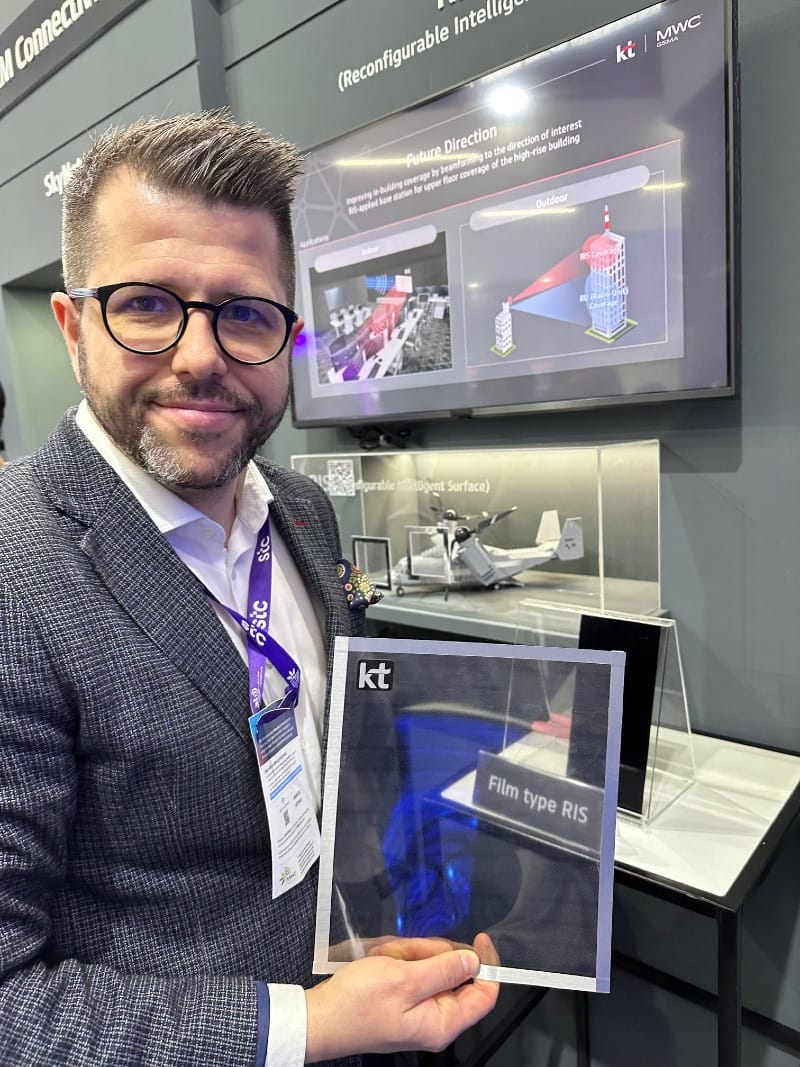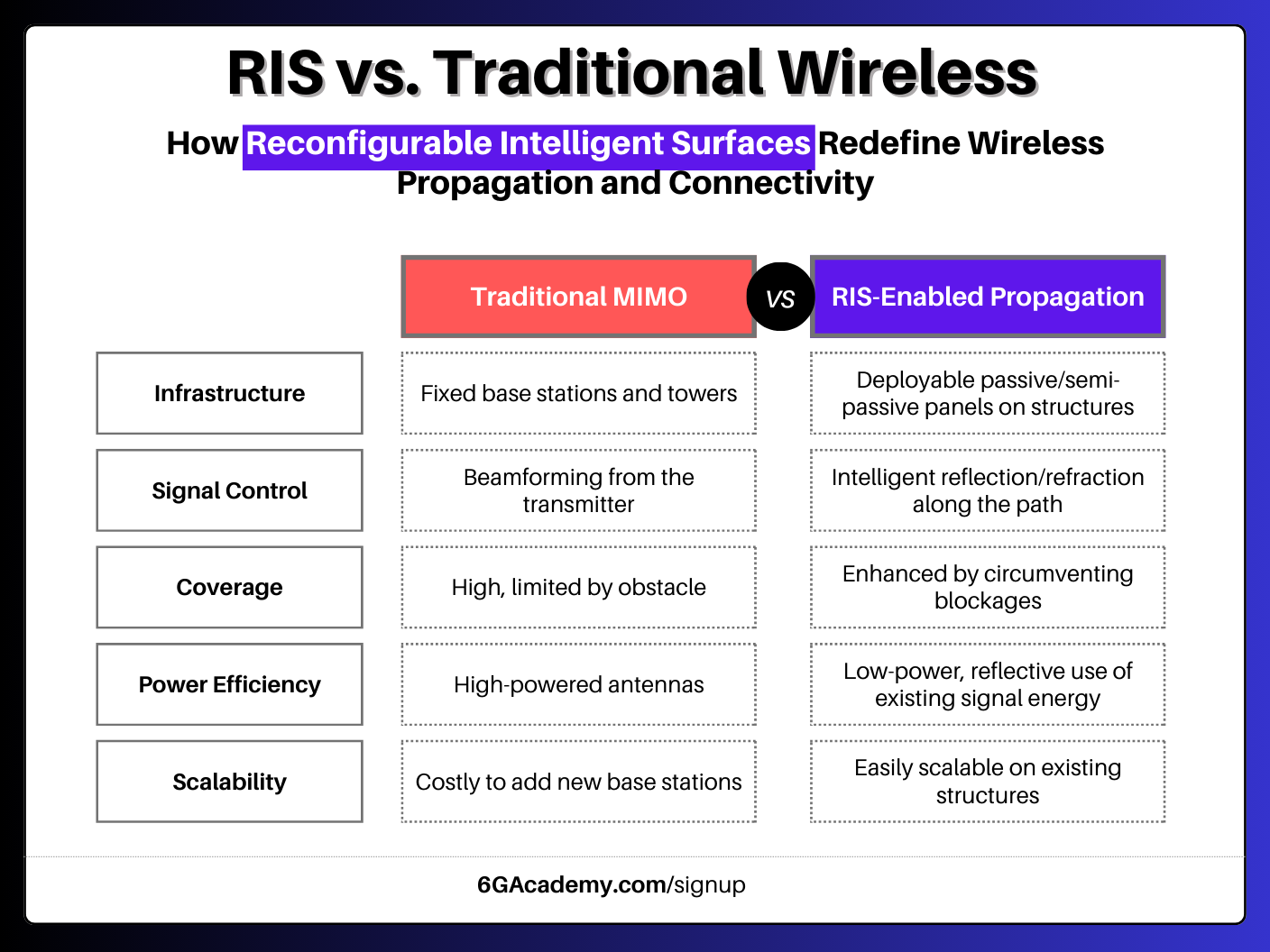By Peter Pietrzyk, 6G Academy
This article is part of our “Key Technologies and Enablers” series. Previously, we explored the transformative potential of AI in wireless communications in What is AI? The Role of Artificial Intelligence in Wireless.
In the world of next-generation wireless communications, we often celebrate explosive data rates, ultra-low latency, and ubiquitous connectivity. But there’s a new star in the line-up that may redefine how signals move through space altogether—Reconfigurable Intelligent Surfaces (RIS). These surfaces are far more than shiny new technology; they’re an entirely new way of thinking about how radio waves interact with their environment.

Below, we explore what Reconfigurable Intelligent Surfaces are, why they matter, and how they’ll shape the future of 6G and beyond.
The Promise of Reconfigurable Intelligent Surfaces
At its core, an RIS is a surface—imagine it like an ultra-thin panel or wallpaper—embedded with a multitude of small reflective elements (often referred to as meta-atoms). These elements can be manipulated in real-time to control how incoming electromagnetic signals are reflected or refracted.
Why should we care? Traditional wireless networks rely on antennas and base stations to transmit and receive signals. But if we could strategically control reflections in the environment (walls, building facades, even furniture), we could direct and shape electromagnetic waves in ways that were never before possible. That means better coverage, higher data rates, and more secure connections.
Key benefits of RIS:
- Beam Shaping and Steering: Precisely control the direction of signal reflections.
- Energy Efficiency: By focusing signals where they’re needed most, power consumption is reduced.
- Improved Coverage: Turn “dead zones” into reliable connectivity hotspots.
- Security and Privacy: Dynamic control of signals can help mitigate eavesdropping and jamming.
👉 Check out our credentials on AI-Driven Spectrum Management and Dynamic Spectrum Sharing.
Traditional Propagation vs. RIS-Enabled Propagation
In current 5G networks, advanced antenna arrays (like massive MIMO systems) serve as the front line of beamforming. While they’ve been successful in boosting coverage and throughput, they still have limitations:
- Fixed Infrastructure: Base stations are deployed in fixed locations, limiting adaptability.
- Signal Blockages: High-frequency signals (think millimeter waves) struggle with obstacles.
- Energy Constraints: Even the most powerful antennas have finite power budgets.
Reconfigurable Intelligent Surfaces attack these challenges from a different angle—literally. Instead of more power and more antennas alone, RIS introduces an environment that intelligently collaborates with existing infrastructure to guide signals around obstacles and optimize coverage.
Here’s a quick comparison table to illustrate the differences:

Diving Deeper: How Does an RIS Work?
Meta-Atoms:
RIS panels are made of tiny cells (meta-atoms) that can be electronically controlled. Each of these cells can alter the phase, amplitude, or polarization of an incoming wave. By coordinating how each cell behaves, the overall reflection from the panel can be shaped as desired.
Passive vs. Semi-Passive vs. Active Surfaces:
- Passive RIS uses minimal energy, primarily reflecting signals.
- Semi-Passive RIS includes low-power amplifiers to slightly boost signals.
- Active RIS can fully amplify and re-transmit signals, though at higher energy and complexity costs.
Control Signals and Algorithms:
Because each cell’s response is electronically controllable, a network controller or base station must instruct the RIS on how to configure its reflection patterns. This often involves advanced optimization algorithms that factor in user locations, channel conditions, and network loads.
Use Cases and Examples
- Indoor Hotspots
- Challenge: Poor in-building penetration of millimeter wave signals.
- RIS Solution: Place RIS panels on walls and ceilings to reflect and direct signals from a single base station, turning coverage holes into hotspots with high data rates.
- Extended Coverage in Rural Areas
- Challenge: Sparse networks and long distances reduce coverage quality.
- RIS Solution: Deploy large-scale RIS panels on existing structures (like barns, highway billboards, or water towers) to redirect signals from distant towers into previously unreachable areas.
- Smart Cities and IoT
- Challenge: Dense environments with multiple obstacles (buildings, vehicles, etc.).
- RIS Solution: Flexible deployment on streetlights, bus stops, building facades—wherever it can minimize dead zones, optimize coverage, and help IoT devices maintain consistent connectivity.
- Secure Communications
- Challenge: Sensitive data transmissions that risk eavesdropping or jamming.
- RIS Solution: Dynamic reflection patterns can be leveraged to confine signals to specific physical zones or mitigate interference from known malicious actors.
Early Adopters:
| Industry | Adoption Timeline | Key Drivers |
|---|---|---|
| Telecommunications | Early | Direct impact on network performance. |
| Smart Cities | Early | IoT and urban connectivity demands. |
| IoT | Early to Mid-term | Low-power, reliable connectivity. |
| Defense and Security | Early | Critical need for secure communications. |
| Rural Connectivity | Early to Mid-term | Cost-effective infrastructure in remote areas. |
| Transportation | Mid-term | V2X and smart transport integration. |
| Healthcare | Mid to Late-term | Growth of smart healthcare systems. |
| Media and Entertainment | Mid-term | High data rates for AR/VR and streaming. |
| Energy and Utilities | Mid to Late-term | Smart grid and infrastructure needs. |
These industries will drive the early adoption of RIS due to their distinct needs for enhanced connectivity, cost efficiency, and security.
👉 Explore 6G Academy Pro Membership benefits and start your journey today!
The Road to 6G: Where Do RIS Fit In?
6G will not be just an incremental upgrade over 5G. Concepts like terahertz frequencies, artificial intelligence-driven network management, and semantic communications are rewriting the rulebook. In that grand vision, Reconfigurable Intelligent Surfaces act as the invisible hand shaping signal propagation—every physical surface (walls, windows, roads) might eventually become part of the wireless network itself.
RIS in the 6G Toolbox:
- Intelligent Reflectors in concert with AI-based resource management for seamless coverage.
- Energy Harvesting from ambient signals to power ultra-low-power IoT devices.
- Adaptive Security that changes reflection patterns on-the-fly to thwart threats.
Potential Challenges and Research Directions
While RIS look promising, there are still hurdles to overcome:
- Design Complexity: Achieving cost-effective, scalable manufacturing of RIS panels requires new materials and designs.
- Control Algorithms: Coordinating thousands (or millions) of meta-atoms in real time demands robust algorithms and computing power.
- Standardization: The industry needs a unified approach for how RIS panels interface with existing base stations, controllers, and user devices.
- Power Efficiency: Passive RIS are energy-friendly, but more advanced semi-active or active versions can become power-hungry.
- Regulatory Hurdles: Regulatory bodies will have to define standards and limits on how signals can be manipulated in the environment.
Tips for Deployers and Researchers
- Start Small: Deploy pilot-scale RIS in controlled environments (e.g., large conference halls, campuses) to validate performance gains.
- Collaborate Across Sectors: RIS isn’t just for telecom. Construction, materials science, and even interior design might have a seat at the table to integrate these surfaces into everyday environments.
- Stay Agile: The technology is young, so expect frequent breakthroughs and iterations in design, algorithms, and deployment best practices.
- Security by Design: Incorporate security considerations from the outset, ensuring that reconfigurable surfaces don’t introduce new vulnerabilities.
Closing Thoughts
Reconfigurable Intelligent Surfaces represent a paradigm shift in how we think about radio propagation. No longer is the wireless channel a pesky obstacle to be overcome with brute force. Instead, the environment itself becomes an intelligent, programmable asset—one that can be finely tuned to meet our connectivity needs.
As 6G visions become clearer, RIS will likely play a starring role in ensuring everyone, everywhere, can experience seamless, energy-efficient, and reliable wireless coverage. Think of RIS as the secret ingredient in the recipe for a future where walls and windows aren’t barriers—but building blocks for next-level communication.
Suggested Reading & Next Steps
- Comparative Studies: Explore published research on RIS prototypes and trials, comparing coverage and power consumption against traditional MIMO setups.
- Practical Deployments: Keep an eye out for pilot programs in smart city initiatives—these often provide real-world data on the effectiveness of RIS solutions.
- Ongoing Innovations: Track emerging academic works on materials science breakthroughs that reduce the cost and complexity of manufacturing RIS at scale.
Thank you for reading! If you found this article valuable, consider sharing it with colleagues and join us HERE for more on the exciting road to future of connectivity.









